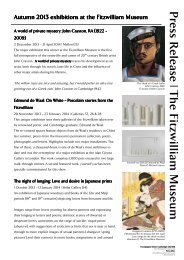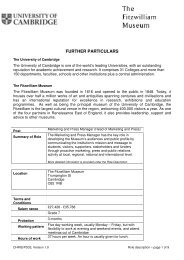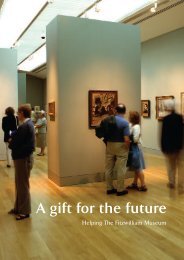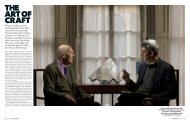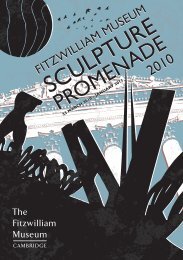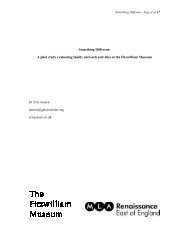The Fitzwilliam Museum - University of Cambridge
The Fitzwilliam Museum - University of Cambridge
The Fitzwilliam Museum - University of Cambridge
You also want an ePaper? Increase the reach of your titles
YUMPU automatically turns print PDFs into web optimized ePapers that Google loves.
52 Lucy Harington<br />
Major Acquisitions<br />
(1581-1627)<br />
Portrait Medal <strong>of</strong> Lucy Harington,<br />
Countess <strong>of</strong> Bedford by Nicholas<br />
Briot (c.1579-c.1646)<br />
1625<br />
silver, cast and chased,<br />
5.3 x 4.2 cm<br />
CM.2111.2003<br />
Purchased from the Cunliffe<br />
Fund, with a grant from the<br />
National Art Collections Fund.<br />
Lucy Harington, Countess <strong>of</strong> Bedford<br />
(1581–1627) was one <strong>of</strong> the most<br />
interesting and vivacious women in<br />
court circles in the early 17th century.<br />
She was a companion <strong>of</strong> James I's<br />
Queen, Anne <strong>of</strong> Denmark, and his<br />
daughter, Elizabeth <strong>of</strong> Bohemia, and a<br />
patroness <strong>of</strong> the poets John Donne and<br />
Ben Jonson, and the architect Inigo<br />
Jones. A portrait at Woburn Abbey shows<br />
her in a masque costume designed for<br />
her by Inigo Jones, with a plume <strong>of</strong><br />
heron feathers similar to that shown on<br />
the medal. She was a collector <strong>of</strong> art and<br />
ancient coins, and this medal is one <strong>of</strong><br />
the first in England to be commissioned<br />
by a private citizen. It is known only<br />
from this one piece, which may well<br />
have been the specimen produced for<br />
the collection <strong>of</strong> the sitter herself.<br />
<strong>The</strong> medal is the work <strong>of</strong> Nicholas Briot<br />
a celebrated French coin engraver,<br />
medallist and inventor <strong>of</strong> minting<br />
machinery. He held the post <strong>of</strong><br />
engraver-general at the Paris mint from<br />
1606 to 1625, but in the Summer <strong>of</strong><br />
1625 he moved to England, where he<br />
became the principal die-engraver at the<br />
Royal Mint. This silver medal, produced<br />
shortly after Briot's arrival in England, is<br />
work <strong>of</strong> a superb quality <strong>of</strong> which only<br />
he was capable at this period.



